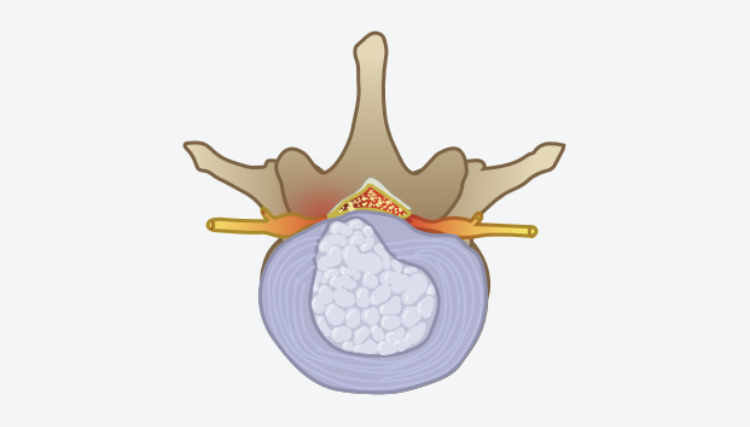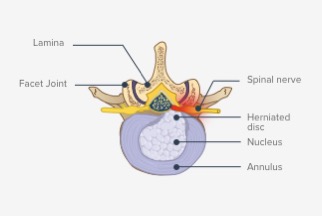Lumbar Microdiscectomy
What Is Lumbar Microdiscectomy?
A lumbar discectomy is a surgery performed to remove a herniated disc or degenerative disc in the lower spine. An incision is made in your back, so your doctor can remove the disc pressing on the nerves. This procedure may be recommended if physical therapy or medication fail to relieve leg or back pain, or if you have signs of nerve damage like weakness or loss of feeling in the legs.
This is a procedure meant to remove damaged discs from the spine and relieve pressure on your spinal nerves. A discectomy can be performed anywhere along the spine from the neck to the low back, depending on where the damage is.
The term “discectomy” literally means cutting out the disc and lumbar means “in the back”.
There are a few techniques your doctor may use to perform a discectomy. These include:
Open Technique
This technique includes large skin incisions and total muscle retraction so that the doctor can directly view the area. It’s typically more invasive than other techniques but may be used if they need better access to the area.
Micro-Endoscopic Discectomy
A microdiscectomy is performed with a “minimally invasive” technique: This technique is known in the medical world as a micro-endoscopic discectomy. This includes using a small skin incision, a surgical microscope and micro-surgical techniques. A microdiscectomy requires a smaller incision and will remove only that portion of your ruptured disc which is pinching one or more spinal nerve roots.
Depending on your condition, your doctor will decide which technique will be most effective.
What Are Intervertebral Discs?
The bony vertebrae of your spinal column are separated from one another by pads of tough cartilage, called intervertebral discs. These discs act like shock absorbers during activity, allowing the spine to move freely.
At the centers of each intervertebral disc are the relatively soft, gelatinous cushions (nucleus pulposis) surrounded by a thick fibrous cover (annulus fibrosis). As your body ages, the disc’s nucleus begins to stiffen. This reduces flexibility and increases the chances that a disc may rupture, especially in the lumbar spine which carries so much of your body’s weight.
A herniated disc is a protrusion of the nucleus through the annulus which in turn presses against a nerve traveling through the spinal canal.
What Happens When a Disc Ruptures?
When the outer lining of a disc tears, its center may rupture and press on a spinal nerve against the bony surface of a vertebra. This condition is often referred to as a ruptured disc. You could think of it as having a tube of toothpaste with a crack in it. Exert pressure on the cracked tube, and toothpaste flows out the crack. Even pressure from everyday activities can push the disc’s nucleus through the ruptured annulus and pinch one or more spinal nerve roots.
Discs herniate most commonly in the lower back, although they also occur frequently in the lower neck.
Causes
Your lumbar spine supports the weight of your entire upper body and is under stress every day. The effects of aging can contribute to a disc rupture. In some cases, the rupture happens during the course of everyday activities. In other cases, it occurs as the result of a specific injury. Usually there is no way to prevent it from happening, though you can reduce your risk by staying in good physical condition and by using proper lifting techniques.
Herniations in the lumbar and cervical spine increase in frequency in patients 30-50 years old because the flexibility and regenerative ability of youth is slowly replaced with the stiffness and disc degeneration of older age.
Signs & Symptoms
When a lumbar spinal nerve is pinched, you may experience pain in your lower back, numbness in your legs or feet, and weakness in your legs or feet,. The pain can come from the pressure on the nerve, the swelling within the nerve (caused by the pressure) or injury to the nerve itself. Taking pain medication or drugs which reduce the swelling may provide relief, but healing may not occur as long as the nerve itself remains pinched.
Diagnosis
Diagnostic examinations have a specific purpose. There are several kinds of imaging tests, including spinal X-rays, CT scans, MRIs and other more detailed imaging tests, such as myelograms, that can confirm the findings of your physical exam.
Treatment Options
There are many different kinds of treatments available. Most doctors will agree that initially, non-surgical treatment is best, unless there is clear evidence of severe nerve involvement.
The three basic non-surgical approaches are as follows:
- For some patients, all that is required in order to heal and recover is time.
- For others, medication may reduce the inflammation or ease the pain in the affected area.
- For some, physical measures such as physical therapy or gentle exercise may provide relief and aid in the recovery from a ruptured disc.
Lumbar microdiscectomy surgery is usually recommended only when specific conditions are met. In general, surgery is recommended when a ruptured disc is pinching one or more spinal nerve root(s) and you have:
- leg pain which limits your normal daily activities
- significant loss of sensation and weakness in your legs or feet
- impaired bowel or bladder function
Follow Us
Request An Appointment
Address: 3273 Claremont Way, Ste. 201, Napa, CA 94558
Phone: 707-603-1042


